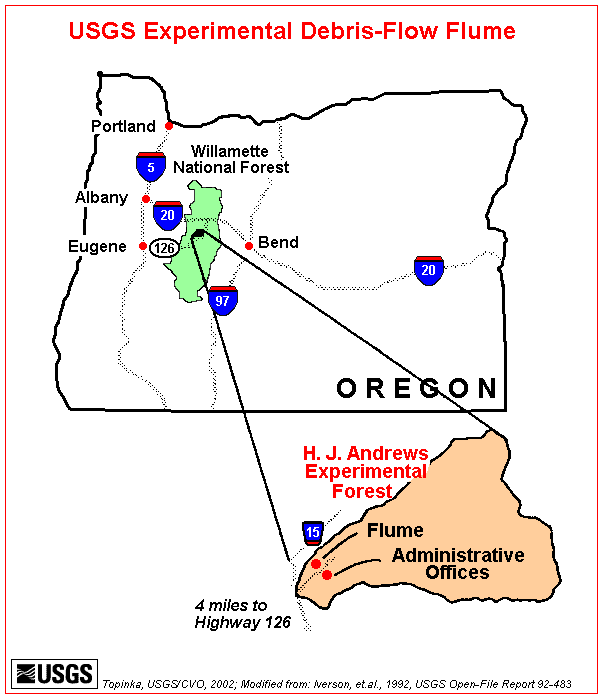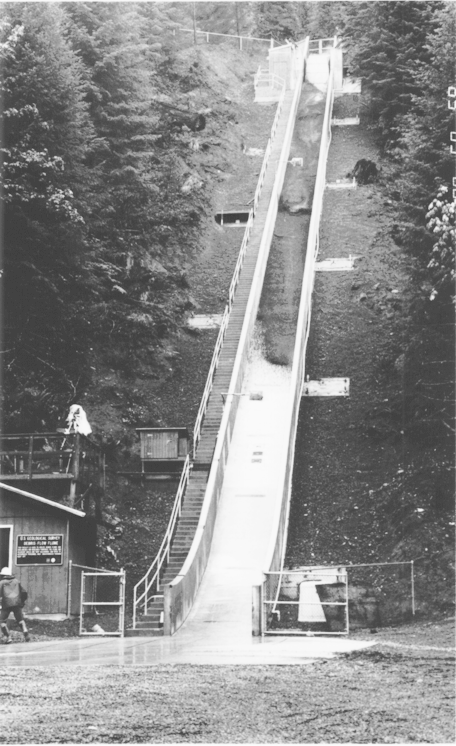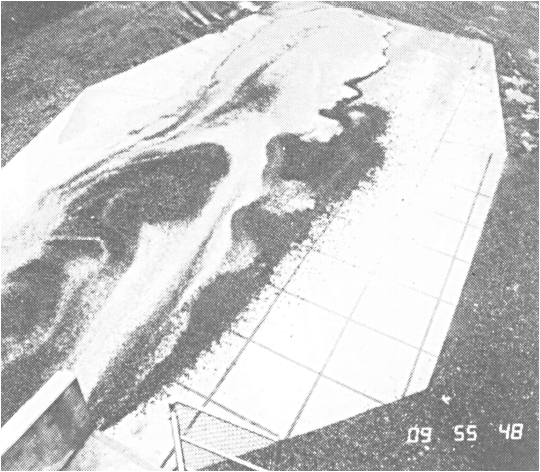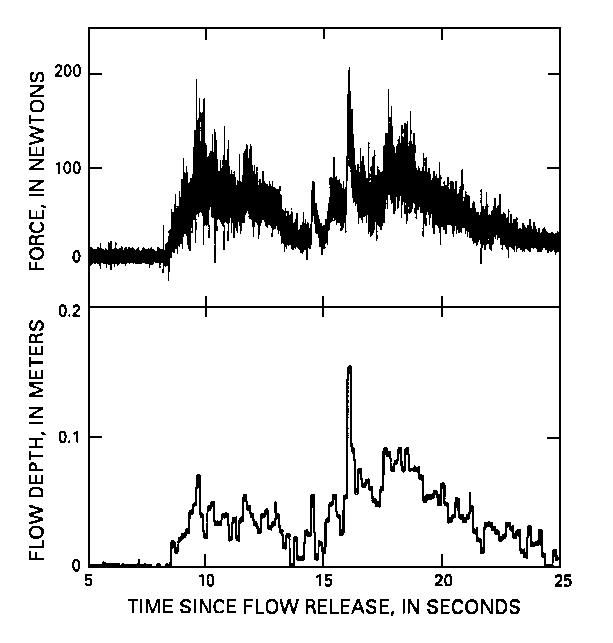Debris-Flow Flume at
|
||||
DEBRIS FLOWSDebris flows are churning, water-saturated masses of rock, soil, and organic matter that rush down mountain slopes. They typically originate as landslides and course down stream channels when they reach the valley floor, leaving lobate deposits of debris in their wake. Debris flows commonly include 60 to 70 percent solid particles by volume and attain speeds greater than 10 meters per second (22 miles per hour). As a consequence, debris flows can denude slopes, damage structures, drastically alter streams, and occasionally cause loss of human life. They are common phenomena in mountainous areas worldwide, including the Appalachians, Adirondacks, Rockies, Great Basin ranges, Sierra Nevada, Cascades, and Coast Ranges of the United States. Typically triggered by intense rainfall or rapid snowmelt, debris flows sometimes occur in conjunction with other hazardous phenomena, such as volcanic eruptions and lowland flooding. Notable recent debris-flow disasters resulted in 150 deaths in central Virginia in 1969, in hundreds of millions of dollars of property damage and tens of deaths in California between 1978 and 1982, and in more than 23,000 deaths near Nevado del Ruiz volcano, Colombia, in 1985.
DEBRIS-FLOW FLUMEScientific understanding of debris flows has been hampered by their unpredictable timing, location and magnitude, which make systematic observation and measurement of natural events both difficult and dangerous. Consequently, in 1991 the U.S. Geological Survey (USGS), in cooperation with the U.S. Forest Service, constructed a flume to conduct controlled experiments on debris flows. Located about 45 miles east of Eugene, Oregon, in the Cascades Range foothills near the headquarters of the H.J. Andrews Experimental Forest, Blue River Ranger District, Willamette National Forest, this unique facility provides research opportunities available nowhere else (fig. 1).
The flume is a reinforced concrete channel 95 meters (310 feet) long, 2 meters (6.6 feet) wide, and 1.2 meters (4 feet) deep that slopes 31 degrees (60 percent), an angle typical of terrain where natural debris flows originate (fig.2). Twelve large bolts grouted into deep boreholes and tensioned to concrete pads adjoining the flume help anchor the structure to the underlying soil and rock. Removable glass windows built into the side of the flume allow flows to be observed and photographed as they sweep past. Eighteen data-collection ports in the floor of the flume permit measurements of forces due to particles sliding and colliding at the base of flows.
To create a debris flow, up to 20 cubic meters (about 40 tons) of sediment are placed behind a steel gate at the head of the flume, saturated with water from subsurface channels and surface sprinklers, and then released. Alternatively, a sloping mass of sediment can be placed behind a retaining wall at the flume head and watered until slope failure occurs. The ensuing debris flow descends the flume and forms a deposit on a nearly flat runout surface at the flume base (fig. 3). The flume design thus accommodates research on all stages of the debris-flow process, from initiation through deposition. Experiments can be conducted using a variety of materials, from mixtures of well-sorted gravel and water to heterogeneous natural slope debris. Experimental materials are recycled by excavating deposits with a front-end loader, placing them in a dump truck, and hauling them back to the staging area at the head of the flume.
SCIENTIFIC OBJECTIVESThe debris-flow flume provides opportunities to make key measurements that have never before been possible. The measurement program aims to satisfy two broad objectives: (1) to test existing mathematical models and develop new models for interpreting and forecasting debris-flow behavior and (2) to develop improved technologies for mitigating the destructive effects of debris flows.Improved models of debris-flow behavior require better understanding of how momentum is transported and energy is dissipated in debris flows. Measurements of flow-front velocities, flow-surface velocities, flow depths, vertical velocity profiles, and shear and normal forces at the channel bed help quantify the mechanisms of momentum transport and energy dissipation (fig. 4). Additional insight can be gained by using ultrasonic imaging to "see" into the interior of flows and by deploying "smart rocks" containing miniature computers that record the rocks' accelerations as they move downslope. Flume experiments also test the accuracy of debris-flow speed estimates made on the basis of the height of mud lines preserved on channel obstacles and at channel bends.
Historically, most interpretations of debris-flow behavior have been based on reconstructions from the sedimentological record. These interpretations have seldom been verified with real-time measurements of flow dynamics. Detailed real-time measurements at the debris-flow flume constrain interpretations of the sedimentology and morphology of debris-flow deposits at the base of the flume. Such well-constrained interpretations may revolutionize sedimentologic studies of debris-flow deposits, much as flume studies of stream processes revolutionized fluvial sedimentology several decades ago. With better sedimentologic understanding and modeling capabilites, it should be possible to assess and predict debris-flow hazards with more accuracy than has been possible in the past. Technologies for mitigating debris-flow hazards include automated detection and warning systems as well as engineering countermeasures that protect high-risk areas. For example, at Mount St. Helens in Washington, Redoubt Volcano in Alaska, and Pinatubo Volcano in the Philippines, the USGS has successfully deployed an automated debris-flow detection system. The system senses ground vibrations caused by passing debris flows and radios an alarm to receivers downstream, allowing time for evacuation of people and property. Experiments at the debris-flow flume aim to improve understanding of ground vibrations caused by debris flows and to refine the automated detection system. The flume also provides an ideal environment for testing engineering countermeasures such as structures that deflect, trap, or channelize debris flows. Experiments that assess how debris flows react to and act upon such structures can guide engineering designs. The ability to control and replicate debris flow characterisitics in the flume allows researchers to evaluate mitigative measures more systematically than if research were focused only on natural events.
USGS Open-File Report 92-483 |





